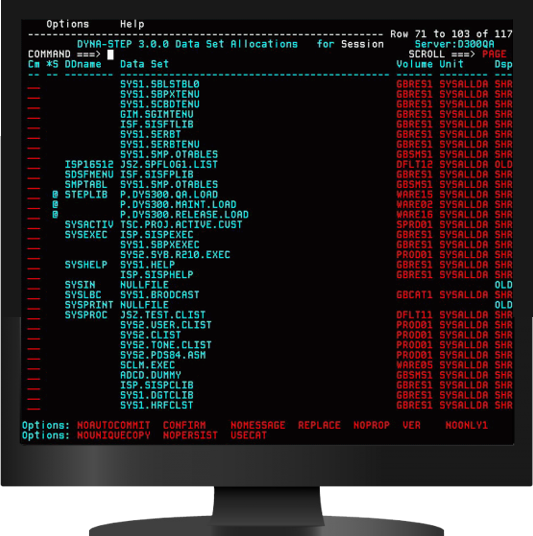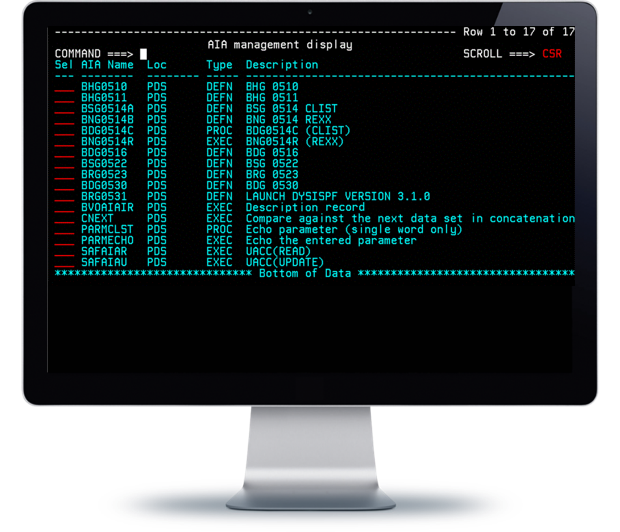DYNA-STEP™
Dynamic STEPLIB and Library Management
DYNA-STEP ISPF Interface Speeds Management of Allocations and the ISPF Environment
The DYNA-STEP ISPF interface enables users to rapidly create and manage allocations through easy to use ISPF panel options that present a full screen display of current allocations in a TSO session, including STEPLIB.
Using the visual interface, users can manipulate concatenations beyond the single execution of the DYNA-STEP command, to modify allocations or perform ISPF functions on displayed datasets. Datasets within an allocation can be inserted, copied, moved or deleted.
When allocations are committed, the actual re-allocation is accomplished by internal execution of the DYNA-STEP command. The DYNA-STEP command options to be used when performing these re-allocations can be modified via a convenient Options display.

Test Multiple Software Versions Side by Side with the Unique DYNA-STEP RENT Command
DYNA-STEP enables users to concurrently run multiple copies of identically named reentrant load modules, each in a separate ISPF screen.
Through this unique capability, users can significantly speed upgrades of key applications and tools, such as QMF, DB2 or SAS.
Simply adding the RENT keyword to existing DYNA-STEP command invocations is all it takes to gain access to multiple copies of the same load modules from different libraries on different ISPF screens. Users can then easily test new releases and software versions side by side with current versions.
Application Initiation Assist Facility – AIA
The DYNA-STEP Application Invocation Assist (AIA) facility enables z/OS teams to define easy-to-use keywords that dynamically allocate and invoke specific application environments for authorized users. Users simply enter the DYNA-STEP AIA keyword to invoke their application environment.
Further, AIA streamlines global application environment changes, enabling z/OS teams to simply update their AIA definitions to invoke new application versions, without changes to keywords in use throughout the user community. As a result, user retraining is eliminated, operational disruption is minimized, and user productivity is retained across application changes and Upgrades.
Additional security benefits are also realized, enabling z/OS teams to initiate and disable application access for users through the AIA definitions, without exposing application specific libraries or definitions.
DYNA-STEP Options Deliver Maximum Flexibility
DYNA-STEP provides the ability to either replace an existing STEPLIB environment or create a push down stack in front of or behind the existing allocations. DYNA-STEP™ retains library authorization, suppresses version messages, and includes unit and volume operands in case the specified dataset is uncataloged.
Numerous optional parameters allow authorized users to manage the environment for maximum productivity, and include:
- ADD – Add library allocations to an existing STEPLIB environment.
- PUSH – Create a push down stack of STEPLIBs, saving the old environment and allowing nested sets of allocations.
- FRONT or BACK – Specify additional STEPLIB allocations to be concatenated in front or in back of the existing environment.
- PROP or NOPROP – Specify whether dynamic STEPLIBs allocated are to be propageted to other ISPF screens.
- AFTER, BEFORE and POS – Specify the exact location in the concatenation to add a new dataset(s).
- FILE – Dynamically allocate / alter a closed TSO DD statement allocation.
- PERSIST – Request that DYNA-STEP give each ISPF screen a unique allocation for the specified DD names.
- USECAT – Use the catalog to locate the data set, rather than relying on the previous allocation
- GENERIC – Allocate dataset(s) to a system specified DDNAME, (such as SYSnnnnn), and dynamically return that DDNAME as a variable in a CLIST or REXX EXEC.
DYNA-STEP LIBDEF Support
DYNA-STEP provides full LIBDEF support for ISPF-related allocations, enabling users to manage their ISPF-related DDnames such as ISPMLIB, ISPPLIB, etc. Further, standard ‘setup’ type CLISTs and REXX procedures can utilize all of DYNA-STEP’s capabilities for setting up the entire environment (including ISPF elements, such as images, messages, panels, skeletons, and tables).
DYNA-STEP Saves System Resources
DYNA-STEP Reduces Contention
TSO STEPLIB directories are searched each time a TSO command is entered, causing high contention on the STEPLIB DASD volumes. DYNA-STEP™ reduces DASD search time, and therefore DASD contention.
DYNA-STEP Shortens Response Time
Program fetch is invoked each time a TSO command is entered, therefore the STEPLIB libraries are searched every time a user hits enter. DYNA-STEP™ reduces the size of the list to be searched, and the associated search time. The result is improved user response time and faster access to volumes for other users.
DYNA-STEP Reduces System I/Os
TSO STEPLIBs use CPU cycles and I/O to search the STEPLIB directories for every command. With DYNA-STEP, the I/O associated with long and repetitive DASD search operations is reduced.
DYNA-STEP Increases DB2 Flexibility
DYNA-STEP™ provides a flexible tool to expedite migration between DB2 test and production versions. Using DYNA-STEP™, DBAs can STEPLIB to multiple DB2 systems, execute multiple DB2I sessions, and access different DB2 subsystems.
DYNA-STEP™ Improves Service Levels
Users enjoy faster LOGON procedures, better response time, and overall better system performance, resulting in increased user productivity and higher user satisfaction levels.
DDYNA-STEP™ Provides Full Security
DYNA-STEP allocates standard OS partitioned datasets for the STEPLIB functions, allowing complete compatibility with all popular security packages including CA-ACF2, CA-TOP SECRET, and RACF.
This enables installations to restrict user access to libraries as STEPLIB datasets. Further, all authorized code used by the DYNA-STEP SVC is located within the SVC to further ensure security and the integrity of DYNA-STEP functions.
In addition, a SAF interface is invoked for all DYNA-STEP functions to validate that users are authorized to perform the DYNA-STEP functions requested, such as ADD and LIST. The DYNA-STEP command runs as a TSO Command Processor, allowing the command limiting features of most security products to restrict user access to DYNA-STEP facilities.
DYNA-STEP™ is Fully Supported on all z/OS Releases and is SMP/E Compliant
DYNA-STEP is certified through a rigorous testing process, and supports the latest z/OS operating system releases. Further, TONE is an active member of IBM PartnerWorld for ISVs, and actively participates in the IBM System z ISV Early Program, which enables TONE to fully test and certify DYNA-STEP on new IBM operating system software releases before they become generally available.
SMP/E-based compliant installation and maintenance is provided for DYNA-STEP, and the DYNAISPF load module can be utilized for installations that need to maintain the ISPEXITS module in the z/OS SMP/E CSI. In addition, the DYNAISPF interface supports multiple servers, enabling maintenance testing to occur without updates to the ISPEXITS load module.


